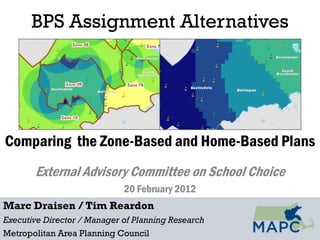MAPC_EAC_SchoolChoice_presentation_2_20_13
- 1. BPS Assignment Alternatives Comparing the Zone-Based and Home-Based Plans External Advisory Committee on School Choice 20 February 2012 Marc Draisen / Tim Reardon Executive Director / Manager of Planning Research Metropolitan Area Planning Council
- 2. Zone-Based Assignment Model Zone 1 Zone 2 A B C 3+ 2 1 Walk 1 2 3+ miles Zone miles Tier 1 & 2 Tier 3 & 4 Choices for Family A Choices for Family B Choices for Family C Tier 1 & 2: 3 schools 2 schools 1 school Tier 3 & 4: 7 schools 6 schools 4 schools 2
- 3. Status Quo Total ŌĆ£Choice BasketŌĆØ ranges from 25 to 36 schools Large discontinuities across zone boundaries 3
- 4. 11-Zone Plan ŌĆ£Choice BasketŌĆØ ranges from 3 to 16 schools More zones = more boundaries = more discontinuity Unequal number of choices within a zone 4
- 5. 11-Zone: Quality Availability of Tier 1 & 2 range:1 to 9 schools Students near zone boundaries have greatest number of choices 5
- 6. Home-Based (A) Assignment A B C 3+ 2 1 Walk 1 2 3+ miles Zone miles +1 more school Choices for Family A Choices for Family B Choices for Family C Tier 1 & 2: 4 schools 4 schools 4 schools Tier 3 & 4: 4 schools 4 schools 3 schools 6
- 7. Home-Based/A ŌĆ£Choice BasketŌĆØ ranges from 6 to 15 schools Variation more gradual across the city and related to school density and/or lack of quality nearby No major discontinuities at zone boundaries 7
- 8. Home-Based/B ŌĆ£Choice BasketŌĆØ ranges from 9 to 18 schools Variation more gradual across the city and related to school density No major discontinuities at zone boundaries 8
- 9. 11-Zone: Quality Tier 1 & 2 availability range: 1 to 9 schools Students near zone boundaries have greatest number of choices 9
- 10. Home-Based/A: Quality Tier 1 & 2 availability range: 4 to 6 schools Gradual variation across the city; greatest availability in SW Boston 10
- 11. Home-Based/B: Quality Tier 1 & 2 availability range: 6 to 9 schools Gradual variation across the city; greatest availability in SW Boston 11
- 12. Home-Based/A Walk Zone Reliance Many areas heavily reliant on out-of-walk- zone access to higher quality schools, especially Mattapan, South Boston, Allston/Brighton, East Boston 12
- 13. Home-Based/B: Walk Zone Reliance As requisite number of high-quality schools increases, most areas rely on out-of-walk-zone schools for quality 13
- 14. Walk Zone Access, by Race Count of Tier 1 and Tier 2 Schools in Walk Zone, by Race/Ethnicity 100% 96% 90% 77% 80% 70% Percent of Students 54% 60% 50% 40% 26% 30% 20% 10% 8% 4% 1% 0% Zero One or more T or More wo Three or More Four or More Five or More Six or More Number of Tier 1 or Tier 2 Schools in Walk Zone White Black Hispanic Asian T or Other R wo ace Total (labeled) 14















